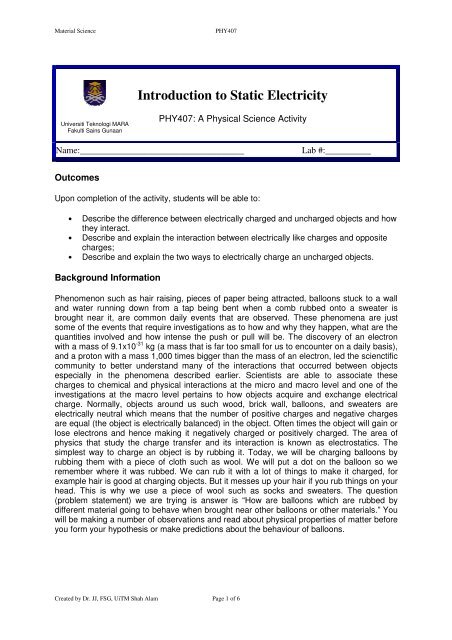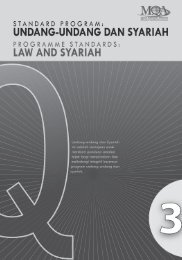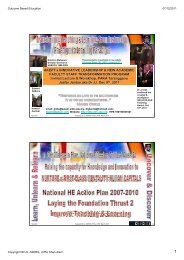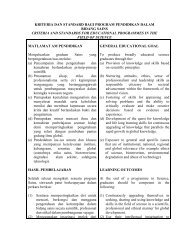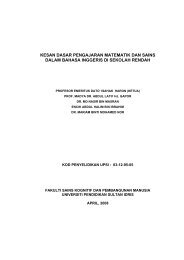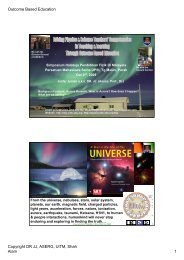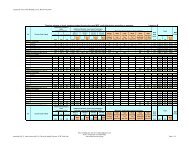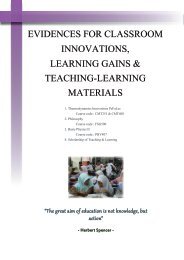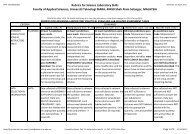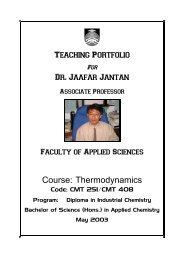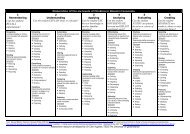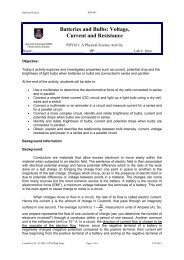Basic Physics II Evidences - DrJJ - UiTM
Basic Physics II Evidences - DrJJ - UiTM
Basic Physics II Evidences - DrJJ - UiTM
You also want an ePaper? Increase the reach of your titles
YUMPU automatically turns print PDFs into web optimized ePapers that Google loves.
Material SciencePHY407Introduction to Static ElectricityUniversiti Teknologi MARAFakulti Sains GunaanPHY407: A Physical Science ActivityName:____________________________________Lab #:__________OutcomesUpon completion of the activity, students will be able to:• Describe the difference between electrically charged and uncharged objects and howthey interact.• Describe and explain the interaction between electrically like charges and oppositecharges;• Describe and explain the two ways to electrically charge an uncharged objects.Background InformationPhenomenon such as hair raising, pieces of paper being attracted, balloons stuck to a walland water running down from a tap being bent when a comb rubbed onto a sweater isbrought near it, are common daily events that are observed. These phenomena are justsome of the events that require investigations as to how and why they happen, what are thequantities involved and how intense the push or pull will be. The discovery of an electronwith a mass of 9.1x10 -31 kg (a mass that is far too small for us to encounter on a daily basis),and a proton with a mass 1,000 times bigger than the mass of an electron, led the scienctificcommunity to better understand many of the interactions that occurred between objectsespecially in the phenomena described earlier. Scientists are able to associate thesecharges to chemical and physical interactions at the micro and macro level and one of theinvestigations at the macro level pertains to how objects acquire and exchange electricalcharge. Normally, objects around us such wood, brick wall, balloons, and sweaters areelectrically neutral which means that the number of positive charges and negative chargesare equal (the object is electrically balanced) in the object. Often times the object will gain orlose electrons and hence making it negatively charged or positively charged. The area ofphysics that study the charge transfer and its interaction is known as electrostatics. Thesimplest way to charge an object is by rubbing it. Today, we will be charging balloons byrubbing them with a piece of cloth such as wool. We will put a dot on the balloon so weremember where it was rubbed. We can rub it with a lot of things to make it charged, forexample hair is good at charging objects. But it messes up your hair if you rub things on yourhead. This is why we use a piece of wool such as socks and sweaters. The question(problem statement) we are trying is answer is “How are balloons which are rubbed bydifferent material going to behave when brought near other balloons or other materials.” Youwill be making a number of observations and read about physical properties of matter beforeyou form your hypothesis or make predictions about the behaviour of balloons.Created by Dr. JJ, FSG, <strong>UiTM</strong> Shah Alam Page 1 of 6


